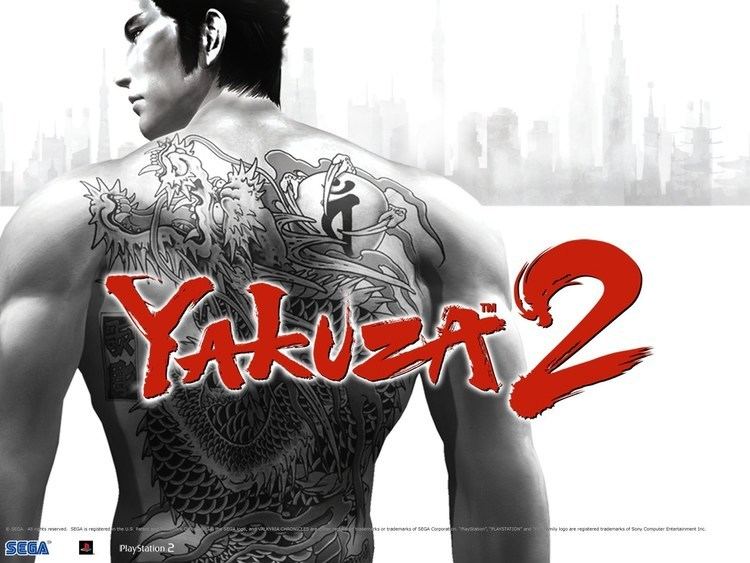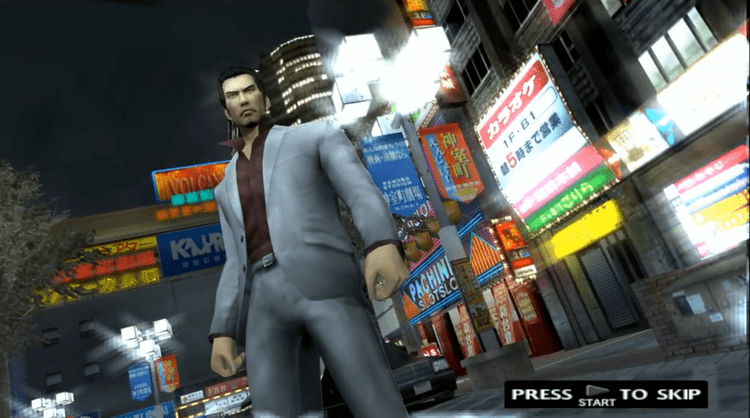9 /10 1 Votes
4.6/5 eBay Composer(s) See Soundtrack Initial release date 7 December 2006 | 4.5/5 Emuparadise 8.5/10 IGN Producer(s) Toshihiro Nagoshi Mode(s) Single-player Writer Hase Seishū | |||||||||||||||||||||||||||||||||
 | ||||||||||||||||||||||||||||||||||
Similar Yakuza games, Sega games, Action-adventure games | ||||||||||||||||||||||||||||||||||
Yakuza 2 part 1 game movie story walkthrough no commentary
Yakuza 2 (Japanese: 龍が如く2, Hepburn: Ryū ga Gotoku 2, literally "Like a Dragon 2") is the sequel to the action adventure game Yakuza by Sega. The title was released on December 7, 2006, for the PlayStation 2 in Japan and in September 2008 in North America and Europe. The game focuses on the former yakuza Kazuma Kiryu who receives a request for help from his former group, the Tojo Clan, to keep relationships with the eastern group, the Omi Family, stable. Across Kazuma's journey he learns of a Korean mafia group linked with the Omi Family and becomes the rival of the Omi's "Kansai Dragon", Ryuji Goda.
Contents
- Yakuza 2 part 1 game movie story walkthrough no commentary
- Setting
- Story
- Characters
- Development
- Soundtrack
- Marketing
- Reception
- Releases
- PlayStation 3
- Wii U
- References

Yakuza 2 has several new gameplay features over its predecessor. Sega wished to improve the fighting engine based on fan input to provide a far more rich experience while playing the video game. The story was aimed to feature a deep adult love story, something not seen in the prequel. Additionally, for the western versions the original Japanese audio was kept in contrast to the previous game which contained English audio.

Critical reception to Yakuza 2 was positive, with reviewers praising the presentation and fighting system.
Setting

Half of the game takes place in Tokyo's Shinjuku ward, most noticeably a recreation of Shinjuku's red-light district Kabukichō renamed Kamurocho.

The other half takes place in Osaka, with the fictitious Sōtenbori and Shinseicho areas modeled after Osaka's respectively Dōtonbori and Shinsekai districts. Although these areas were recreated as fictionalized versions, many real life landmarks remain such as Dōtonbori's Sammy Ebisu Plaza (サミー戎プラザ) and Shinsekai's Tsutenkaku Tower (通天閣) and Billiken (ビリケン).
Story

The intro of the game starts in the early 1980s: A detective is chasing after somebody and witnesses a murder of a Korean mob boss who says in Korean that the killer was a lying dog and the Korean mob will live on even with the death of its boss. The murderer happens to be Kazuma Kiryu's foster father, Shintaro Kazama (Fuma in the english versions). After Kazama runs off, the detective checks on the man who tells him in Japanese that his child is in danger just before he dies. The detective heads in the direction the man pointed and notices a fire. The detective finds a room where a Korean woman is alone with a baby. The woman tries to throw the baby out the window, but instead leaves the baby to the detective. Time then moves to a year after Yakuza. Since then, the Tojo Clan has been falling apart and they are on the brink of war against the Osaka-based gang, the Omi Family, the gang backing Akira Nishikiyama in the first game. As a last resort, the Tojo Clan requests their former leader, Kazuma Kiryu (4th Chairman) for their help. Kazuma Kiryu and Haruka Sawamura are living a peaceful life and they visit the graves of Yumi Sawamura, Akira Nishikiyama, and Shintaro Kazama. There, the appointed Chairman, Yukio Terada, a former member of the Omi Family, asks for Kazuma Kiryu's aide. However, the Omi Family quickly act and assassinate their former family member Terada and Kiryu heads out for Osaka to find a peaceful solution and prevent an all out gang war across Japan from happening.
In order to protect the Tojo, Kiryu recruits his former comrade Daigo Dojima to replace Terada. However, Daigo decides to accompany Kiryu to Osaka during the clan's meeting to settle a score with the Omi. While in Osaka, Kiryu meets his Kansai equivalent and new rival, Ryuji Goda, the son of the head of the Omi Family, Jin Goda. Though enemies, Ryuji seems to hold a genuine respect for Kiryu and holds him in regard as his equal, hence necessary to vanquish Kiryu as Ryuji believes there's only room for one Dragon in Japan. In the aftermath of the meeting, Jin Goda and Daigo are kidnapped while Kiryu is arrested by the detective Kaoru Sayama who is actually trying to keep him safe as his death would trigger a war. While working with Kaoru and his old friend Makoto Date, Kiryu learns of a Korean mafia group, the Jingweon, which is responsible for kidnapping Daigo and Jin. With help of his allies, Kiryu rescues Daigo and learns more about the Jingweon.
Characters
This is the first game in the series to feature only Japanese voice acting for its U.S. and PAL release as a response to the criticism of the English voice acting in the first game.
Development
Yakuza 2 was first announced in August 2006 with Sega promising an improved fighting system and further exploration. Nagoshi commented on some of his goals with Yakuza 2. In addition to providing a deeper dramatic storyline over what was found in the original, the game also has some themes that were not in the original, including an adult love story. The Sega team considered fan input when making changes to Yakuza 2. One of the main aims in developing Yakuza 2 was improving its fighting engine. Accounting for fights against multiple opponents was one of the most important things that were considered when improving the fighting engine. It was made much easier, for instance, to attack foes that come at you from multiple directions, and to switch targets in the middle of a combo in order to quickly take out someone who may have snuck up on your flank. As a result, the fighting system was polished and the staff believed they succeeded. In localizing the game, the Japanese audio was kept instead of producing an English dub. This proved no difficulties. The team also added more Heat moves to make the fights more exciting.
The director of the voice recordings discouraged the voice actors from falling back on the cliches of anime character acting. When scenes involving characters exchanging insults and threatening each other take on cartoon cadences, the sense of tension and suspense evaporates. The decision not to use an overblown style of acting was what the composer thought it added to the distinctive dramatic feel of the series.
Soundtrack
The Ryū ga Gotoku & Ryū ga Gotoku 2 Original Sound Track (HCV-287) dual-disc boxset was published by Wave Master in Japan on January 25, 2007. The music was composed by Hidenori Shoji, Hideki Sakamoto Norihiko Hibino and Takahiro Izutani. During the development of Super Monkey Ball: Banana Blitz for the Wii, Sega sound manager Haruyoshi Tomita became interested in the company's approach to sound design. As it so happened, Sakamoto was a huge fan of the original Yakuza game title, so being commissioned for the sequel was not the kind of offer that he was about to pass up. Shoji had developed a stimulating guitar sound for the game, so he was interested in seeing what he could do with piano compositions. His use of instruments and editing techniques offered ample resources for him to study upon entering the production side of the series. His own compositional style has its roots in classical music, which might be one distinction that helped differentiate their musical approaches. To write music that complements the compelling depth of the narrative, it was necessary to proceed from the point of view of bridging the gap between the scenarist and the player.
As with the first game a classic gospel, this time Franz Gruber's Silent Night, Holy Night (Stille Nacht, heilige Nacht), is sung in English by Eri Kawai. Singer So Yoki performs Kamuro Setsugekka (神室雪月花). The track list for Yakuza 2 has 27 titles (details are available below).
Additional soundtrack includes two songs by Japanese artist Crazy Ken Band.
Marketing
In order to make realistic recreations of Tokyo's Kabukicho and Osaka's Dohtenbori, Sega made 17 tie-in with famous Japanese companies. As a result, some places found in the game, such as the Don Quijote discount store, the Club Sega game centers and the Matsuya (松屋) restaurants (replacing its unlicensed version called Akagyu) are modeled after the real life buildings. The Tōkaidō Shinkansen high-speed train is also featured in the game.
In order to support the game's expensive production, Sega used product placement strategy and introduced ads within the game. This includes the Japanese coffee brand Boss Coffee, numerous brands of alcohol appearing in the game's bars and pubs including Suntory Whiskey, Jack Daniel's Bourbon or Carlsberg Beer.
Famous real life arcades are included in the game. Sega's UFO Catcher crane game machine is included as a minigame, and arcade cabinets of Virtua Fighter 4 can be seen in the Club Sega game centers.
Reception
Yakuza 2 was the 98th best-selling game in Japan in 2008 selling 136,809 copies that year, while it was the third best-selling PlayStation 2 game in its release year, 2006, reaching lifetime sales of around 830,000 in Japan. 40,000 copies were sold in North America.
Famitsu gave the game a score of 38 out of 40. IGN gave Yakuza 2 a score of 8.5 out of 10, and Diehard GameFAN has given the game a score of Very Good, as well as their 'Best PlayStation 2 Game' award for 2008. Eurogamer rated the game 8 out of 10. In Australia, Hyper has given the game 8 out of 10.
Releases
The Japanese version of the game, Ryū Ga Gotoku 2, was later ported to both, the PlayStation 3 and the Wii U consoles. This remastered edition of the second game in the series is bundled with the original Japanese version of the first game. Both compilations were released exclusively in Japan.
PlayStation 3
On November 1, 2012, a PlayStation 3 HD remaster of the Japanese original version of Yakuza and Yakuza 2 titled Ryu Ga Gotoku 1&2 HD edition was released in Japan. This "HD edition" features both game remasters bundled in a single Blu-ray disc and later in a ~19GB downloadable file.
On December 11, 2014, this "HD edition" was re-released in the budget range "PlayStation 3 the Best" dedicated to best sellers on the Japanese domestic market. Simultaneously to this Blu-ray re-release, a 18.1GB downloadable version was also made available for purchase on the Japanese PlayStation Store.
Wii U
On August 8, 2013, a Wii U HD remaster of the Japanese original version of Yakuza and Yakuza 2 titled Ryu Ga Gotoku 1&2 HD for Wii U was released in Japan. This "HD for Wii U" release features both game remasters bundled in a single disc or in a 19.8GB file for download. This Wii U release is notable for being the first port of the PlayStation-exclusive Yakuza series on a non-Sony platform.
